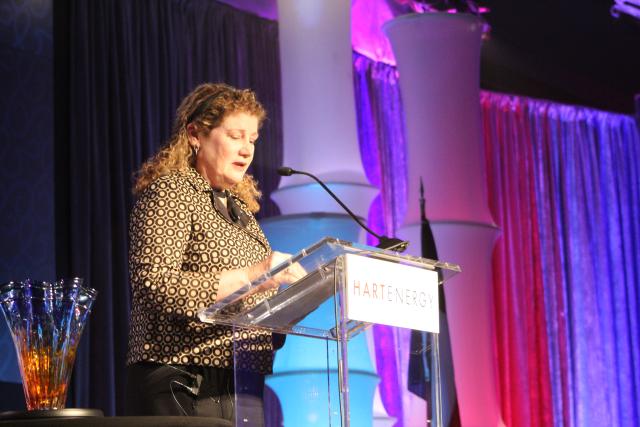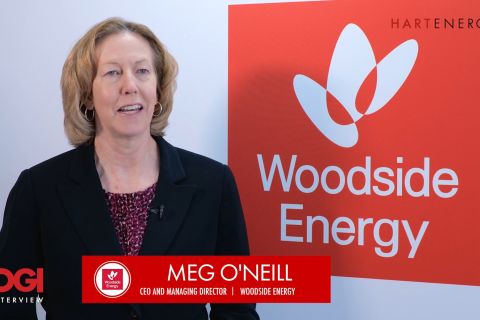
During her keynote address at Oil and Gas Investor’s Women in Energy Luncheon, Susan. J. Helms used her experiences to draw the correlation among space and energy.
HOUSTON—When reaching for the stars seems unattainable, women in the energy industry can look to Susan J. Helms for a path that far succeeds the sky’s limit.
With a warm welcome from nearly 1,100 energy professionals, Helms took the room on a unique journey during her keynote address at Oil and Gas Investor’s Women in Energy luncheon on Feb. 12 that offered insight into new territory for both women and energy.
“It isn’t just any journey; it’s a special trip to space and back on the space shuttle utilizing the wonders of energy in ways you don’t see in your day-to-day life.”
As a retired lieutenant general in the United States Air Force Helms has combined her expertise from the Air Force, which includes flying on over 30 types of aircrafts as a flight test engineer, with her 12-year career as an astronaut with NASA into her role on Concho Resources’ board of directors.
Through the lens of her own experience, Helms visually aided the audience from the launch pad at Kennedy Space Center to the weightless world known as space. An opportunity for the energy-focused audience to identify with all the aspects that go into a space shuttle mission.
“You’re strapped tight into your chair, waiting for the ride of your life. As you lay there on your back listening to the countdown, you become keenly aware that you are very close to your energy source—the cryogenic oxygen and hydrogen rocket fuel—because you can hear and feel the breathing and venting, giving you a sense that the entire spaceship stack is alive,” Helms said.
Unbeknownst to the crowd, Helms’ picturesque effort highlighted the unfamiliar correlation between energy aboard a spaceship and the cosmic universe.
“This rocket fuel is how you’re going to get to orbit, because ordinary oil and gasoline just doesn’t have the right energy qualities to do the job.
“And as it turns out even cryogenic fuels burning through the main engines aren’t powerful enough to lift you off the launch pad. So your shuttle will be assisted by an additional source of energy: two large size rockets that contain a solid fuel mixture of ammonia perchlorate and aluminum. And its good stuff…it’s cheap, reliable and powerful,” she added.
Navigating the audience through the dense atmosphere to a theoretical altitude of 150,000 feet, Helms honed in on the significance of energy. From the essential fuels that launched the riders to the high peak to the energy necessary to sustain them in orbit.
“For any space craft you have to have electricity to run all of the life support systems and experiments that keep you alive from lift off to re-entry and landing, and all of the days in between…” she said. “Gasoline won’t work in part because it’s not a very efficient fuel for its volume and also because astronauts just don’t like the idea of living with spark plugs in an oxygen dominant environment.”
Furthermore Helms explained that solar panels are also an impractical resource for space shuttles because they wouldn’t survive the liftoff or re-entry.
The best choice, she disclosed, is fuel cells. According to Helms, the chemical reaction that is created between oxygen and hydrogen generates proper electricity along with heat and water as byproducts.
“With the oxygen and hydrogen stored in small cryogenic tanks onboard, you have enough energy resources to generate all of the space shuttle electricity for a few weeks,” she said. “Inside the pressurized crew compartment, the flowing electricity is just as ubiquitous as in your home. It’ll be hard to imagine a more perfect energy solution.”
For the typical six month duration of the mission, Helms walked her rather large crew through the typical day to day operations, which include experiments and other professional activities. All of which center around the use of, and precisely managed, renewable energy.
“You transition to a completely different power system…and here renewable energy is very practical,” she said. “Your available power is capped by the capacity of your solar rays and batteries and so every day on the space station energy management is a part of the crew agenda.”
Just as the new dimension starts to become home, the six months are over and a new crew is ready to continue the mission as you head back to Earth, Helms said.
Virtually, the audience must ready themselves to head back and, as she added, “rely on the space shuttle energy systems again to bring you safely back to Earth.”
Thanks to a simple equation between kinetic and potential energy, Helms allowed the relief of landing to cast over the crowd and birth a state of reflection.
“It’s a marvelous adventure…made possible by amazing sources of energy that had been specially tailored for every phase of your mission,” she said.
To a captivated audience, Helms underlined the duty that the current energy community has in shaping the industry’s future. She argued that as technological inspirations reach down into the next generation, the young people of tomorrow “will want to stand on the shoulders of the innovators of today”.
Helms polished off her speech with a hardline stance on the importance of energy going forward.
“The wonders of energy will continue to play a tremendously critical role. Not just in facing our space exploration challenges but in all strategic challenges for the Earth, both predictable and unpredictable.”
“Energy has always been and will always be the strategic enabler of human accomplishments.”
Recommended Reading
Exxon Versus Chevron: The Fight for Hess’ 30% Guyana Interest
2024-03-04 - Chevron's plan to buy Hess Corp. and assume a 30% foothold in Guyana has been complicated by Exxon Mobil and CNOOC's claims that they have the right of first refusal for the interest.
Petrobras to Step Up Exploration with $7.5B in Capex, CEO Says
2024-03-26 - Petrobras CEO Jean Paul Prates said the company is considering exploration opportunities from the Equatorial margin of South America to West Africa.
The OGInterview: How do Woodside's Growth Projects Fit into its Portfolio?
2024-04-01 - Woodside Energy CEO Meg O'Neill discusses the company's current growth projects across the globe and the impact they will have on the company's future with Hart Energy's Pietro Pitts.
NAPE: Turning Orphan Wells From a Hot Mess Into a Hot Opportunity
2024-02-09 - Certain orphaned wells across the U.S. could be plugged to earn carbon credits.
Deepwater Roundup 2024: Offshore Australasia, Surrounding Areas
2024-04-09 - Projects in Australia and Asia are progressing in part two of Hart Energy's 2024 Deepwater Roundup. Deepwater projects in Vietnam and Australia look to yield high reserves, while a project offshore Malaysia looks to will be developed by an solar panel powered FPSO.





